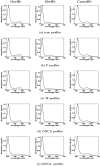Factor analysis for gene regulatory networks and transcription factor activity profiles
- PMID: 17319944
- PMCID: PMC1821042
- DOI: 10.1186/1471-2105-8-61
Factor analysis for gene regulatory networks and transcription factor activity profiles
Abstract
Background: Most existing algorithms for the inference of the structure of gene regulatory networks from gene expression data assume that the activity levels of transcription factors (TFs) are proportional to their mRNA levels. This assumption is invalid for most biological systems. However, one might be able to reconstruct unobserved activity profiles of TFs from the expression profiles of target genes. A simple model is a two-layer network with unobserved TF variables in the first layer and observed gene expression variables in the second layer. TFs are connected to regulated genes by weighted edges. The weights, known as factor loadings, indicate the strength and direction of regulation. Of particular interest are methods that produce sparse networks, networks with few edges, since it is known that most genes are regulated by only a small number of TFs, and most TFs regulate only a small number of genes.
Results: In this paper, we explore the performance of five factor analysis algorithms, Bayesian as well as classical, on problems with biological context using both simulated and real data. Factor analysis (FA) models are used in order to describe a larger number of observed variables by a smaller number of unobserved variables, the factors, whereby all correlation between observed variables is explained by common factors. Bayesian FA methods allow one to infer sparse networks by enforcing sparsity through priors. In contrast, in the classical FA, matrix rotation methods are used to enforce sparsity and thus to increase the interpretability of the inferred factor loadings matrix. However, we also show that Bayesian FA models that do not impose sparsity through the priors can still be used for the reconstruction of a gene regulatory network if applied in conjunction with matrix rotation methods. Finally, we show the added advantage of merging the information derived from all algorithms in order to obtain a combined result.
Conclusion: Most of the algorithms tested are successful in reconstructing the connectivity structure as well as the TF profiles. Moreover, we demonstrate that if the underlying network is sparse it is still possible to reconstruct hidden activity profiles of TFs to some degree without prior connectivity information.
Figures










Similar articles
-
Transcriptome network component analysis with limited microarray data.Bioinformatics. 2006 Aug 1;22(15):1886-94. doi: 10.1093/bioinformatics/btl279. Epub 2006 Jun 9. Bioinformatics. 2006. PMID: 16766556
-
Using a state-space model with hidden variables to infer transcription factor activities.Bioinformatics. 2006 Mar 15;22(6):747-54. doi: 10.1093/bioinformatics/btk034. Epub 2006 Jan 10. Bioinformatics. 2006. PMID: 16403793
-
Unraveling transcriptional regulatory programs by integrative analysis of microarray and transcription factor binding data.Bioinformatics. 2008 Sep 1;24(17):1874-80. doi: 10.1093/bioinformatics/btn332. Epub 2008 Jun 27. Bioinformatics. 2008. PMID: 18586698 Free PMC article.
-
Theory and limitations of genetic network inference from microarray data.Ann N Y Acad Sci. 2007 Dec;1115:51-72. doi: 10.1196/annals.1407.019. Epub 2007 Oct 9. Ann N Y Acad Sci. 2007. PMID: 17925348 Review.
-
Inference of gene regulatory networks using boolean-network inference methods.J Bioinform Comput Biol. 2009 Dec;7(6):1013-29. doi: 10.1142/s0219720009004448. J Bioinform Comput Biol. 2009. PMID: 20014476 Review.
Cited by
-
Regulatory network structure as a dominant determinant of transcription factor evolutionary rate.PLoS Comput Biol. 2012;8(10):e1002734. doi: 10.1371/journal.pcbi.1002734. Epub 2012 Oct 18. PLoS Comput Biol. 2012. PMID: 23093926 Free PMC article.
-
Modelling transcriptional regulation with a mixture of factor analyzers and variational Bayesian expectation maximization.EURASIP J Bioinform Syst Biol. 2009;2009(1):601068. doi: 10.1155/2009/601068. Epub 2009 Jun 11. EURASIP J Bioinform Syst Biol. 2009. PMID: 19572011 Free PMC article.
-
FacPad: Bayesian sparse factor modeling for the inference of pathways responsive to drug treatment.Bioinformatics. 2012 Oct 15;28(20):2662-70. doi: 10.1093/bioinformatics/bts502. Epub 2012 Aug 24. Bioinformatics. 2012. PMID: 22923307 Free PMC article.
-
Gene expression signatures of radiation response are specific, durable and accurate in mice and humans.PLoS One. 2008 Apr 2;3(4):e1912. doi: 10.1371/journal.pone.0001912. PLoS One. 2008. PMID: 18382685 Free PMC article.
-
siVAE: interpretable deep generative models for single-cell transcriptomes.Genome Biol. 2023 Feb 20;24(1):29. doi: 10.1186/s13059-023-02850-y. Genome Biol. 2023. PMID: 36803416 Free PMC article.
References
-
- Ming H, Abuja N, Kriegman D. Face detection using mixtures of linear subspaces. Proceedings Fourth International Conference on Automatic Face and Gesture Recognition. 2000;4:70–76.
-
- Aguilar O, West M. Bayesian dynamic factor models and portfolio allocation. Journal of Business and Economic Statistics. 2000;18:338–357.
-
- West M. Bayesian factor regression models in the "Large p, Small n" paradigm. Bayesian statistics. 2003;7:733–742.
-
- Sabatti C, James G. Bayesian sparse hidden components analysis for transcription regulation networks. Bioinformatics. 2006;22:739–746. - PubMed
Publication types
MeSH terms
Substances
Grants and funding
LinkOut - more resources
Full Text Sources
Miscellaneous

